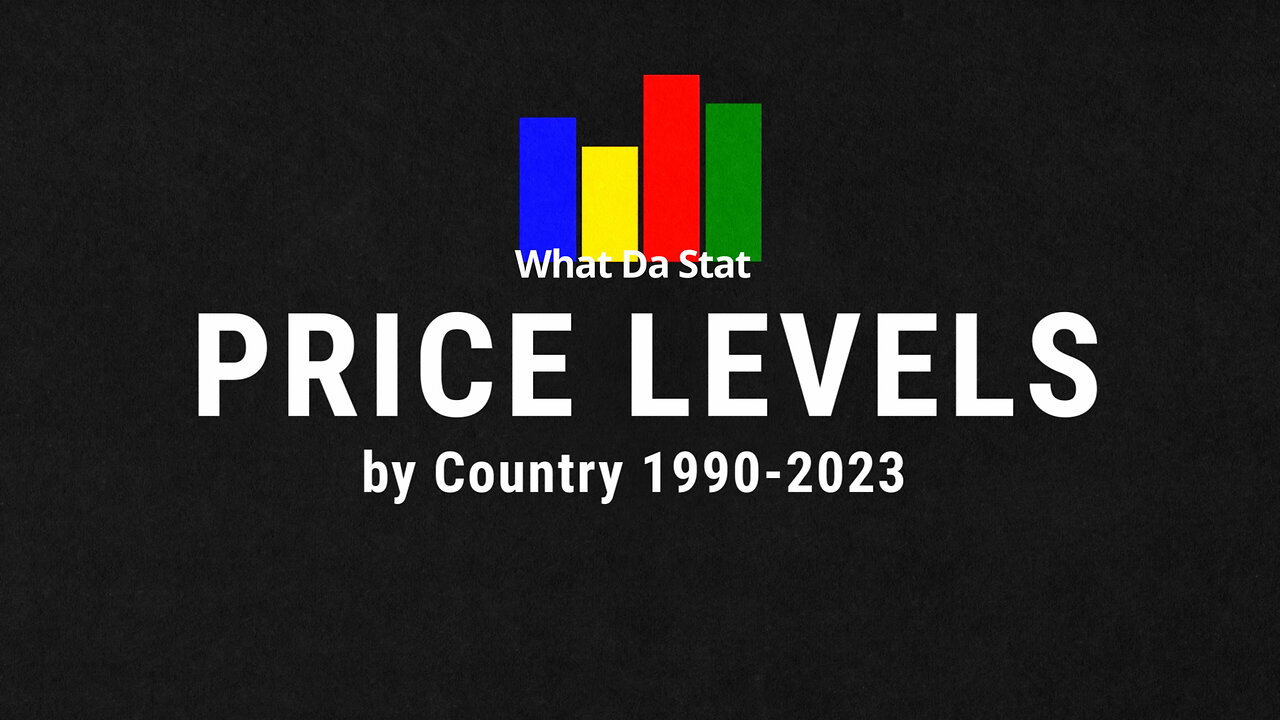Premium Only Content

Countries Price Levels Compared to USA 1990-2023
This bar chart race compares price levels on goods and services in countries/territories compared to United States of America (USA = 0), from 1990 to 2023, highest and lowest.
* The price levels (in percentage) are calculated as:
(Price level ratio of PPP conversion factor (GDP) to market exchange rate) - 1 x 100
The "Price level ratio of PPP conversion factor (GDP) to market exchange rate" is a concept used to compare the cost of goods and services across different countries.
Here’s a simple breakdown:
PPP (Purchasing Power Parity) Conversion Factor: This is a way of adjusting money so that you can compare what a certain amount of money can buy in different countries. For example, $10 might buy more things in India than in the United States. The PPP conversion factor adjusts for these differences.
PPP Conversion Factor (GDP): This specifically refers to the adjustment made to a country's GDP to reflect the true purchasing power of its currency. It tells us how much of the country's GDP is needed to buy the same basket of goods and services that you could buy with the GDP of another country, after adjusting for price differences.
Market Exchange Rate: This is the rate at which you can exchange one country's currency for another. For instance, if 1 US dollar can be exchanged for 100 Japanese yen, that's the market exchange rate.
Price Level Ratio: This ratio compares the PPP conversion factor to the market exchange rate.
If the ratio is 1, it means that the market exchange rate perfectly reflects the difference in prices between two countries.
If the ratio is greater than 1, it means that things are generally more expensive in that country when using the market exchange rate compared to what the PPP suggests.
If the ratio is less than 1, it means that things are generally cheaper in that country when using the market exchange rate compared to what the PPP suggests.
In essence: This ratio helps to understand whether a country’s currency is overvalued or undervalued in terms of its purchasing power. If the price level ratio is high, the country might seem expensive when using the market exchange rate, while a low ratio might indicate that the country is cheaper.
No data: American Samoa, Cuba, Channel Islands, Gibraltar, Guam, Isle of Man, Northern Mariana Islands, New Caledonia, North Korea, French Polynesia, British Virgin Islands, Cuba, North Korea, Lichtenstein, Monaco, Niue, Tokelau no data.
Limited data: Curacao from 2011, Cayman Islands from 2006, Djibouti from 2011, Faroe Islands from 2008, San Marino 1999, Sint Maarten (Dutch part) from 2011, Syria from 2017, U.S. Virgin Islands from 2002, Kosovo from 2008, Venezuela until 2011, Yemen until 2013.
Data source: International Comparison Program, World Bank | World Development Indicators database, World Bank | Eurostat-OECD PPP Programme.
Music:
Alexander Nakarada - Fractions www.serpentsoundstudios.com
Licensed under Creative Commons BY Attribution 4.0 License http://creativecommons.org/licenses/by/4.0/
Data visualization created with flourish.studio https://flourish.studio
-
 1:44:36
1:44:36
RiftTV
5 hours agoBREAKING: Trump FEDERALIZES D.C. To RESTORE Law & Order | The Rift | Ryan Matta, Olivia Krolczyk + Braeden Sorbo
36.6K12 -
 LIVE
LIVE
megimu32
3 hours agoOTS: Breakfast Nostalgia + Blind Chocolate Cereal Showdown… LIVE! 🍫🥣
80 watching -
 LIVE
LIVE
LIVE WITH CHRIS'WORLD
11 hours agoLIVE WITH CHRIS’WORLD - It’s Called LAW & ORDER
111 watching -
 11:07
11:07
AlaskanBallistics
1 day ago $1.02 earnedBreek-Lok Quick Detach Hub Mount and Flash Hider System Review
21.5K2 -
 57:44
57:44
Donald Trump Jr.
7 hours agoExclusive Interview with Deputy Secretary of State Chris Landau | Triggered Ep266
108K50 -
 58:40
58:40
BonginoReport
11 hours agoModern Dating Woes & How To Resist Temptation w/ Tilly Dillehay - Hayley Caronia (Ep.109)
43.7K15 -
 53:55
53:55
The Quiet Part
10 hours agoThey Want You to Sign Over Your Life Insurance—So They Can Keep Lying to You
17.9K10 -
 1:47:05
1:47:05
The Mike Schwartz Show
7 hours agoTHE MIKE SCHWARTZ SHOW Evening Edition 08-11-2025
18.4K6 -
 2:00:22
2:00:22
Quite Frankly
8 hours ago"D.C. Crackdown, Weekend News, World-Changing Inventions" 8/11/25
18.8K4 -
 1:25:09
1:25:09
Kim Iversen
6 hours agoTrump’s DC Crackdown: America’s El Salvador Moment?
77.9K112